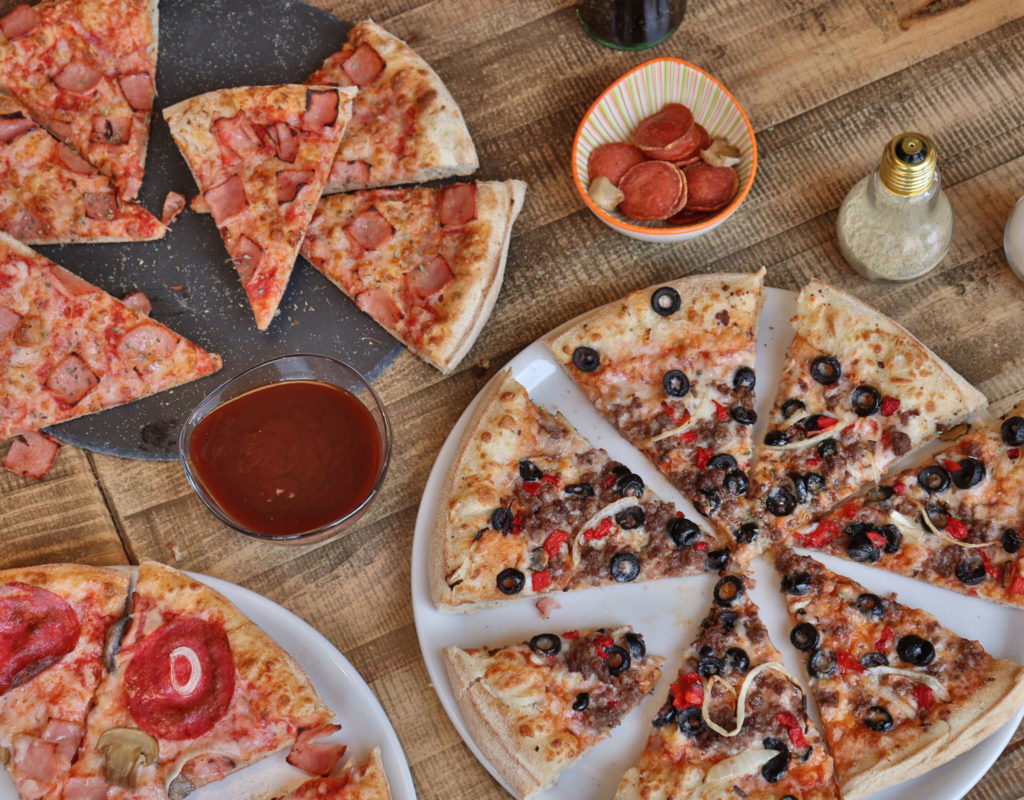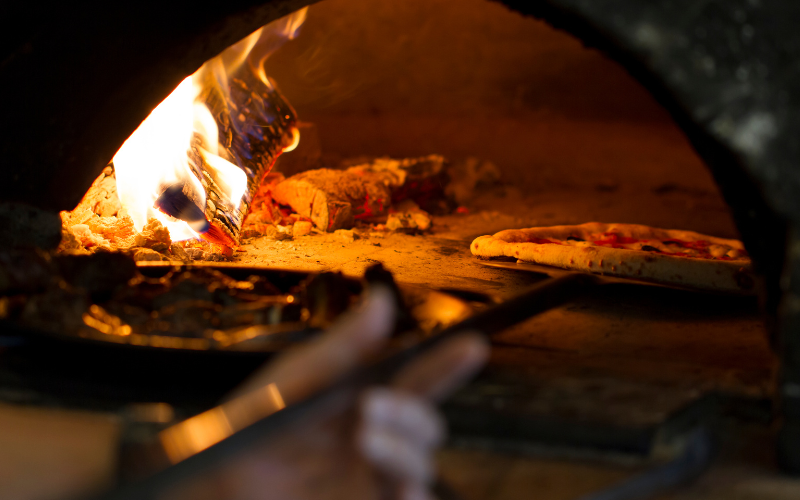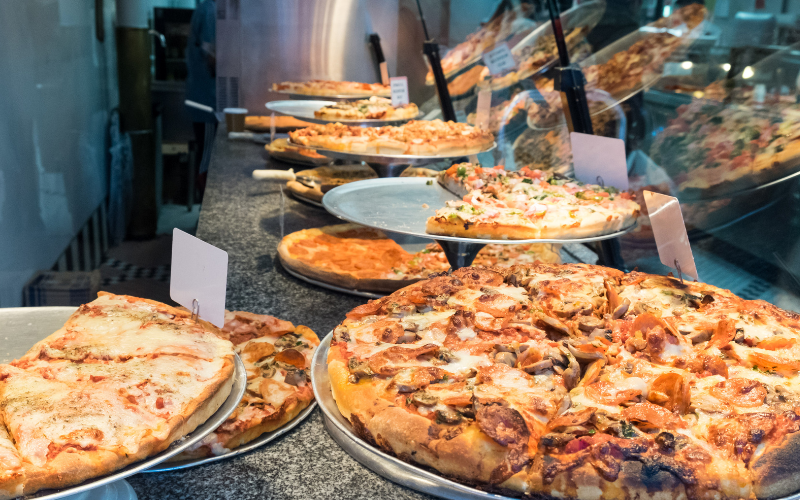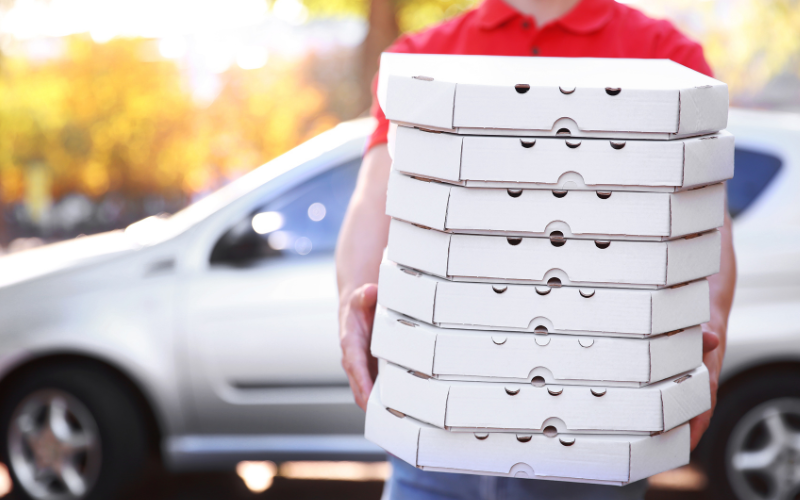Food safety for Pizzerias: HACCP, labelling and all you need to know
Several sources estimate that close to 5 billion pizzas were consumed in 2023…
W-O-W!
That’s a lot of pizza!
The global pizza market reached a value of $233.26 billion by the end of 2023.
Incredible, isn’t it?
And while determining the absolute “favourite” pizza flavors worldwide in 2023 is difficult, several toppings continue to lead the charts:
- Pepperoni: Consistently ranks high in many countries, especially the US.
- Margherita: The classic with mozzarella, tomato, and basil remains popular globally.
- Mushrooms: Often a crowd-pleaser with widespread appeal.
- Cheese: A simple yet beloved option across regions.
- Sausage: Popular in various forms, like Italian sausage or pepperoni’s spicy cousin.
With all that much pizza being consumed everywhere, it’s extremely important to keep food safety in our pizzerias top of mind.
And precisely for that reason, Andy’s team, led by our food safety consultant Nerea Cristófalo, has created this mega guide on food safety in pizzerias worldwide, following some of the best practices of many of our clients in this industry.
So, if you have questions about food safety in pizzerias, you’ll find them here!
Let’s get started!
What are the main food safety risks in pizzerias?
Ingredient reception, dough preparation, and pizza baking are critical points in pizza production, as these represent key moments where contaminants and health hazards can be introduced.
Let’s take a detailed look at the different food safety risks in pizzerias:
- Cross-contamination: This occurs when raw foods come into contact with cooked or ready-to-eat foods, resulting in the potential spread of harmful bacteria.
- Improper food handling: If food is handled incorrectly, it can become contaminated with harmful bacteria. This can happen if pizzeria employees do not wash their hands properly, do not use clean gloves or utensils, or if food is not stored correctly.
- Temperaturas inadecuadas: Pizza must be cooked at a proper temperature to kill bacteria. If the pizza is not cooked enough, dangerous bacteria may survive and can cause illness.
- Improper food storage: If pizza ingredients are not stored correctly, they can become contaminated with bacteria and other harmful microorganisms.
- Spoiled ingredients: If the ingredients used to make pizza are not fresh or are spoiled, they can be harmful to health.
- Water contamination: If the water used to prepare pizza is not safe, there may be harmful bacteria that cause illness.
- Lack of a food safety plan: If a pizzeria does not have an adequate food safety plan, there may be a higher risk of contamination and foodborne illnesses.
What food safety practices should be followed at a pizzeria?
To minimise and avoid the hazards described in the previous section, appropriate control measures must be established:
From verifying the quality of received ingredients to controlling temperature and hygiene during dough preparation and pizza baking, cleaning and disinfecting equipment and surfaces used, and proper personal hygiene practices to prevent cross-contamination during food handling.
But, let’s go step by step.
Best food safety practices recommended for receiving food in pizzerias:
All pizzerias should carry out an appropriate raw material reception process to ensure the quality and safety of the products.
The temperature of frozen or refrigerated foods received must be taken and recorded, as well as checking the condition of the merchandise and recording whether it is correct or incorrect.
When the temperature or condition of the merchandise does not meet the established requirements, there should be a record of this incident and a note should be made in the corresponding product or maintenance incident section.
In addition, the corrective measure taken to solve the problem must be indicated.
Best food safety practices recommended for product inspection:
It is important to check the appearance of all stored foods daily to ensure that they do not show signs of spoilage, mold, or any other indication that they may be damaged.
Likewise, the expiration date of stored foods must be checked daily to ensure that they have not expired.
Check that the foods are correctly labelled and stored according to their type and characteristics, thus avoiding possible cross-contamination between different types of foods.
Best food safety practices for food storage and preparation in pizzerias:
Food storage and preparation in pizzerias are critical processes that must be carried out properly to avoid health risks to consumers.
One of the preventive measures is to record the temperature of the displays of the cameras, chests, and ingredient tables to ensure that they are within the established limits.
This process must be carried out rigorously and periodically, and immediate corrective measures must be implemented in case of detecting any anomaly.
Good hygiene practices in pizzerias during food handling:
Hygiene during food handling is key to prevent contamination and ensure food safety.
Preventive measures must be taken to ensure the cleanliness and disinfection of the facilities, as well as the personal hygiene of the workers. One of these measures is to check daily that the restroom has soap, paper, cold and hot water.
Good practices for making pizza dough: recipes and order of ingredients
To achieve quality pizzas in a pizzeria, it is essential to pay attention to every stage of the production process, particularly to the dough, thawing and stretching it at the right time according to the recipe and type of dough.
Once ready, ingredients must be added in the correct order, starting with the sauce and cheese, considering the preferences and dietary restrictions of customers.
Additionally, it is crucial to ensure the freshness and proper storage of ingredients to avoid contamination and spoilage.
In other words, the quality of pizzas depends on carefully following all established guidelines and maintaining high food safety standards at all times.
Good food labelling practices in pizzerias:
Expiry labelling for prepared food in restaurants isn’t universally mandated across many regions worldwide, however good practice dictates labelling for prepared and stored food for internal food safety and tracking purposes.
Europe:
- No EU-wide legislation mandates expiry labelling for prepared and stored food in restaurants.
- Member states set their own regulations: Some countries, like Belgium or France, have national guidelines recommending labelling with preparation date and shelf life.
- HACCP principles remain crucial: Restaurants must implement Hazard Analysis and Critical Control Point (HACCP) plans, ensuring safe food handling and storage, even without mandatory expiry labels.
United States:
- Similar to the EU, no federal mandate for expiry labelling in restaurants.
- FDA Food Code provides recommendations: Suggests labelling prepared and stored TCS foods (Time/Temperature Control for Safety) with a discard date based on safe handling practices.
- State and local regulations may apply: Specific requirements vary, with some states mandating labelling in certain situations (e.g., buffets).
Australia:
- Food Standards Code provides guidance: Recommends labelling opened or prepared unpackaged food with the date prepared and expected discard date.
- Individual states may have stricter regulations: For example, New South Wales mandates labelling with preparation date and discard date for certain high-risk foods.
Japan:
- No specific nationwide mandate for expiry labelling in restaurants, however, regulations encourage proper food handling and storage practices.
- Industry guidance often recommends labelling prepared and stored foods with dates.
In Spain, the law that regulates how food labels should be is Royal Decree 126/2015, of February 27.
According to this regulation:
food labels must include clear and precise information about the name of the food, the list of ingredients (with allergens highlighted), nutritional information, expiration date or minimum duration, conditions of conservation and/or use, and identification of the lot.
But, that’s not all.
A pizzeria must also label with secondary expiration in different situations: for example, when a food is opened, when it is thawed, changed to an airtight container, or when the original label comes off or deteriorates.
Good baking practices for pizzerias:
During the baking phase in pizzerias, it is necessary to perform a series of checks to ensure the quality and safety of the final product.
To do this, the following actions are recommended:
- Check daily that the appearance of the product when it comes out of the oven is as expected, meaning it has been cooked for the established time and temperature for optimal cooking. If the pizza looks deformed or has a poor appearance, the proper functioning of the oven should be checked to address any technical problems that may affect the quality of the product.
- Record the temperature of a baked product when it comes out of the oven, ensuring that the recorded temperature is above 85°C.
- To take the temperature of the baked products, the following steps should be followed:
- Turn on the thermometer.
- Lightly insert the probe into the product as soon as it comes out of the oven.
- Allow the temperature to stabilise.
- Record the obtained temperature.
Oven control is a critical point in pizza production in a pizzeria.
It is important to ensure that the oven temperature remains constant and at an appropriate temperature to ensure that the pizzas are properly cooked and safe for consumption.
Therefore, it is important to regularly monitor the oven temperature using thermometers and temperature records.
Verifying the heat table in pizzerias
The heat table is used to place previously baked and packaged foods while the rest of the customer’s order is being prepared.
Every two weeks, its correct operation should be checked:
- Turn on the heat table and let it heat up for a few minutes according to the manufacturer’s instructions.
- Place a kitchen thermometer on the surface of the heat table and wait a few seconds for the temperature to stabilize.
- Verify that the temperature of the heat table is between 60 and 70 degrees Celsius. This is the ideal temperature to keep the pizzas warm without burning them.
- Place the freshly baked pizza on the heat table and wait a few minutes. Verify that the pizza stays warm and that the cheese melts correctly.
- If the temperature of the heat table is too high or too low, adjust the temperature according to the manufacturer’s instructions.
- Regularly check the temperature of the heat table during service to ensure that it remains constant and that the pizzas stay warm.
How should the cleaning and disinfection of facilities and equipment be carried out in pizzerias to ensure food safety?
To ensure the safety and wholesomeness of food in pizzerias, it is essential to maintain an adequate overall state of order, cleanliness, disinfection, insect control, and rodent control. Therefore, it is necessary to daily check that the following conditions are met:
Preparation: Before starting cleaning and disinfection, it is important for employees to wash their hands and use clean gloves and aprons. Waste and food residues should also be removed from surfaces.
Cleaning: The entire surface of equipment and facilities should be cleaned with water and mild detergent. Employees should use brushes and sponges to scrub surfaces to remove any food residue.
Rinsing: After cleaning surfaces, they should be thoroughly rinsed with clean water to remove any detergent residue.
Disinfection: After rinsing, surfaces must be disinfected with disinfectant chemicals that are safe for use in contact with food. Disinfectant products must be registered and approved by health authorities and should be used according to the manufacturer’s instructions.
Rinse again: After disinfection, surfaces should be rinsed again with clean water to remove any disinfectant residue.
Drying: Surfaces must be completely dry after cleaning and disinfection to prevent the growth of bacteria and mold.
Hygiene plan: It is advisable to establish a regular cleaning and disinfection plan for the facilities and equipment of the pizzeria, including frequency, products, and methods of cleaning and disinfection.
It goes without saying that it’s extremely important for pizzeria employees to receive proper training in cleaning and disinfection practices and that procedures are followed consistently and rigorously to ensure food safety.
What HACCP measures should a pizzeria follow?
As you know, Hazard Analysis and Critical Control Points (HACCP) is a food safety management system used in the food industry to identify, assess, and control hazards associated with food.
While every country / region enforce different HACCP measures, the following are some general principles a pizzeria should follow to ensure food safety:
-
- Hazard identification: The pizzeria should conduct a risk assessment to identify hazards associated with food preparation, including ingredients, preparation processes, and facilities
-
- Determining critical limits: The pizzeria should establish critical limits for critical control points (CCPs) that may pose a food safety hazard. For example, temperature limits for pizza cooking should be established to ensure harmful bacteria are eliminated.
-
- CCPs monitoring: The pizzeria should regularly monitor CCPs to ensure that established critical limits are being met. This may include monitoring storage temperature and food cooking temperature.
-
- Corrective actions: If a deviation from established critical limits is detected, the pizzeria should take corrective actions to address the situation. This may include adjustments to food preparation processes, removal of contaminated food, or review of food safety plans.
-
- Verification: The pizzeria should verify that the HACCP system is functioning correctly and that established critical limits are being met. This may include reviewing monitoring records and conducting microbiological tests on prepared foods.
-
- Documentation: The pizzeria should document all HACCP measures taken and maintain accurate records of food preparation processes and implemented food safety measures.
It is important for the pizzeria to follow guidelines established by local and national health authorities and adequately train its staff in food safety procedures and HACCP.
What type of health inspections can be expected a a pizzeria?
Pizzerias can be subject to regular health inspections by public health authorities to ensure compliance with food safety standards and prevent foodborne illnesses.
Some aspects of food safety in pizzerias that are evaluated during these inspections may include:
- Hygiene of facilities and kitchen equipment.
- Cleanliness of the premises, including dining areas and bathrooms.
- Control of food storage and cooking temperatures.
- Monitoring of food expiration dates.
- Proper food handling and prevention of cross-contamination.
- Food safety training for staff.
- Recordkeeping of products and their origin.
- Storage of cleaning products out of reach of food.
- Protection of food from potential insects, rodents, and other animals.
Failure to comply with food safety standards may result in penalties and temporary closure of the pizzeria until issues are resolved.
That’s why, pizzerias need to meet requirements and undergo regular health inspections to ensure the food safety of their customers.
How do you ensure the food safety of a pizza for delivery?
To ensure the food safety of a pizza for delivery, certain measures should be followed to prevent contamination and maintain product quality during transportation.
Some of these measures include:
Delivery control:
It is important to ensure that pizzas are delivered under safe conditions, keeping them hot and avoiding cross-contamination during transportation. Tracking procedures should be established to verify that orders are delivered safely and corrective measures should be taken if any issues are identified.
Tareas para el repartidor:
Delivery drivers have a significant responsibility in pizza delivery, as they must ensure that orders are delivered safely.
Clear procedures should be established for drivers, such as checking the quantity and quality of orders before delivery, ensuring they are delivered within the established time frame, keeping pizzas hot, and avoiding cross-contamination during transportation.
Food Safety for pizzerias: How to train your team
It’s important for a pizzeria to properly train its employees in food safety to ensure the quality and safety of its products.
Here are some general guidelines that can be followed to train employees on food safety:
Specific Food Safety Training in Pizzerias: The pizzeria should provide employees with adequate training in food safety, covering topics such as personal hygiene, food temperature control, prevention of cross-contamination, proper food handling, and cleaning and disinfection of facilities and kitchen utensils.
Food Safety Manuals: The pizzeria should provide employees with food safety manuals that describe the business’s food safety policies and procedures.
Food Safety Practices: The pizzeria should teach employees to follow food safety practices, such as washing hands before and after handling food, using gloves and kitchen caps, storing food properly, and avoiding cross-contamination.
Supervision and Monitoring: The pizzeria should supervise employees and ensure they are following food safety procedures correctly. It’s also important to conduct periodic follow-ups to ensure employees are complying with food safety standards.
Continuous Update: The pizzeria should ensure that employees are updated on the latest food safety standards and regulations to ensure they are following appropriate practices.
Reinforcement of the Importance of Food Safety: The pizzeria should reinforce the importance of food safety and its impact on customer health and brand reputation.
Properly training employees on food safety is essential to ensure the quality and safety of the pizzeria’s products and to avoid public health issues.
Food Safety for pizzerias: Can technology help?
In one word: ABSOLUTELY!
The Digital Food Safety Assistant Andy becomes a friendly ally that will help you meet, improve, and perfect your operational goals, improve productivity, save costs and time, and above all, protect the health of your customers and the reputation of your pizzeria.
A digital assistant is a digital entity that acts as one more in the kitchen, thinking and guiding the rest of the team intelligently.
Andy works hand in hand, facilitating the actions to be taken so that your food safety processes are correctly fulfilled at all times.
Andy is trusted by the big pizza and foodservice names worldwide from Starbucks to Domino’s Pizza, and many, many more.
Big and small pizzerias use Andy to guide their teams in their food safety tasks in a friendly and intelligent way, preventing, caring, and ensuring that quality work is done in the shortest possible time.
Andy digitises all actions relevant to food safety processes, traceability, labelling, and workspace hygiene, significantly reducing the time the team spends on them and facilitating compliance with all HACCP, hygiene, food labelling protocols.
Here are some of the tasks Andy helps with to keep pizzeria kitchens free from consumer risks:
1. Digital HACCP
Andy digitises cleaning and hygiene records, maintenance, temperatures, and any necessary checklists, ensuring they are always in compliance with the law.
Thanks to the automation of HACCP protocols with Andy, all mandatory records can be complied with while automatically activating corrective actions, streamlining operations, from taking temperatures to implementing corrective actions, setting acceptable limits, and surveillance frequency.
And not only that, right now, restaurants that already work with Andy also measure another very important metric: the internal temperature of cooked and reheated food.
Our partners usually control with Andy the first foods made in the morning shift and the first ones in the night shift.
They take the temperature of a product from each equipment (fryer, oven, bain-marie, etc.), not forgetting the microwave (reheating).
To do this, they standardise the Critical Control Point temperature to >=65ºC.
This way, they ensure that the food has exceeded the critical limit and verify the correct operation of the machinery.
Through previously properly configured action plans, Andy guides the teams at all times.
And that means zero risks caused by the many human errors that understandably can occur when the kitchen becomes a pressure cooker!
👉Keep reading about Digital HACCP with Andy👈
2. Food Safety Labels
Our efficient pizzeria operations software also has the ability to label products and ingredients much faster and simpler, ensuring greater food safety in all types of kitchens.
In fact, we have demostrated that automatic expiration labelling is at least twice as fast as cumbersome manual labelling.
Not automating expiration labelling in your pizzerias is causing you to lose hours worked and dedicated to repetitive tasks that burn out employees…
And that’s wasted salaries and talents.
Continuing with manual expiration labeling means continuing to work with errors that cost time and money.
It means incorrectly labelled food that ends up being wasted.
And it means questionable traceability processes that can negatively impact the reputation and finances of your brand.
👉Learn about efficient food labelling with Andy👈
3. Incident Management
Andy automates any incident that occurs in a commercial kitchen with simple and effective corrective plans.
Andy has the power to help solve the problems that arise and activate the correct action plan to address them in a fraction of the time that kitchen teams typically spend, ideal for ensuring food safety in all types of restaurants.
What happens when a food incident occurs in your pizzeria?
- Andy reacts quickly to a machinery incident
- Resolves the incident with maximum agility and minimum stress
- Monitors the status of the incident
- Recognises incidents and knows how to react
- Coordinates with whoever or the company that needs to resolve the incident
- Follows up on an incident from outside the restaurant.
What benefits does automated incident control with Andy represent for your pizzeria?
- Reduces reaction time to an incident
- Reduces the number of incidents in the establishment
- Reduces the time it takes to manage an incident
- Increases the knowledge of the central office about incidents
- Reduces the time between an incident occurring and the central office reacting.
- Reduces the bureaucracy to be done in the event of an incident.
- Demonstrates that the central office reacts quickly to needs in the establishments
- Longer machinery lifespan
- Avoids unresolved incidents
- Greater supervision of incidents
- Faster reaction time to an incident
- Better coordination between people in resolving an incident
And not only that.
With Andy, training on incident management and food alerts is a much simpler process, as you can easily demonstrate how to manage them with clear and real examples.
What happens when a smaller number of incidents and problems occur in your pizzeria/s?
You create a much happier work environment and a team that feels proud to belong, avoiding the dreaded turnover of staff.
👉Discover how incidents are automated with Andy👈
5. Internal audits
With the integrated audit plan in Andy, you can control participants’ access, customise scores, and collect all inspections in one place.
External health inspectors and auditors love this tool because when records are perfectly kept and presented for them (instead of on wet, torn, or lost papers!), their work becomes infinitely easier.
Moreover, Andy can assist you with the following specific food safety processes in pizzerias, as it does in many kitchens that already trust our digital assistant:
- Detailed ingredient labelling, including vegetables, sauces, desserts, meat, bread, and cheeses.
- Monitoring of product cooking temperatures.
- Daily monitoring of oil renewal records for each fryer.
- Daily monitoring of chlorine levels in water.
- Organisation of cleaning tasks in daily, weekly, bi-weekly, and monthly protocols.
- Record-keeping to keep the list of suppliers up to date.
- Record of raw material reception and thorough control of meat traceability.
- Training record to keep track of the training provided to workers.
So, if you’re embarking on a new business venture, whether it’s in organised catering, institutional catering, food service, hotel groups, or even supermarkets, welcome Andy into your kitchens and ensure food safety day in day out!
Try out the many advantages that the leading digital food service HACCP software can offer to all types of restaurants completely free for 10 days!
Looking forward to working with you!









